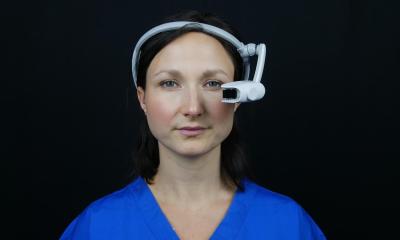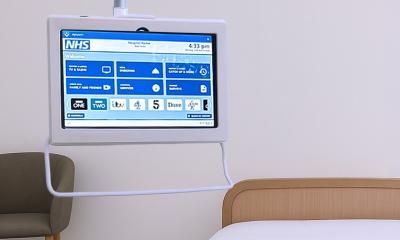
Article • Patient care
Robots will never replace human beings
As the number of patients and people requiring care increases, exacerbating the shortage of care staff for in- and out-patients, care robots might solve the problem. For menial tasks, many devices can contribute well; however, at the complex interactive human level of care, the idea that advancing technologies could replace human caregivers to alleviate staff shortages is clearly simplistic.
Report: Melanie Günther
Robots that perform cleaning or transport tasks, or distribute medication or meals, are now often indispensable in hospitals and clinics, contributing significantly to smooth operations behind the scenes. A robot offered by medical technology provider Xenex, for example, disinfects the environment with UV rays. According to the manufacturer the device can handle 64 rooms a day, calculating its route carefully so as to cover every nook and cranny. The robot is an important aid in the on-going battle against hospital-acquired infections (HAIs) by helping to contain infections caused by pathogens such as Clostridium difficile or MRSA.
Japan’s technology research
For the past few years Japanese companies, such as Panasonic and Toyota, and many research institutes have driven the development of care robots, due to the rise in the country’s aged population and the shortage of care staff, which is even more pronounced than in Germany, for example.
Panasonic developed the RoboticBed, which not only lifts a patient but can also transform into a wheelchair. From the same firm comes the Hospi-Rimo, a tele-presence robot enabling communication between patient and physician. In hospital trials ‘Hospi’ also distributed medication.
- Toyota Motor launched the Care Assist Robot, which lifts hospital and care home patients from the bed or takes them to the toilet.
- Riken, another Japan-based company, follows a similar approach with Robear.
- Drawback: Currently, none of these technologies is marketable because the development and acquisition costs are prohibitive.
Robots – a very distant switch from human caregivers
There is no mass market yet for electronic patient care and the use of robots in clinical routine is still pie in the sky, since none of the high-tech devices recognises emotions or responds to them.
While humanoid robots can indeed simulate emotions, they lack the ‘social skills’ to interact with patients. This is a major issue, as Professor Birgit Wilkes, Head of the Institute of Facility Telematics at the Technical University Wildau, Germany, points out: ‘In my opinion, the use of care robots can contribute greatly to facilitate lifting actions. However, it is incredibly difficult to programme sensitivity into robots so they don’t hurt patients. They simply lack empathy and this is where today’s robots clearly hit the wall.’
Technical assist systems support care staff
Technical assist systems are quite a different story: they can improve difficult working conditions in in-patient care, be it in hospital or geriatric care, by supporting staff and relieving strain on the caregivers. In 2015, Germany’s Fraunhofer Institute for Manufacturing Engineering and Automation (IPA) developed a prototype of an intelligent care trolley. This can be summoned, contain care material and documents material use, and thus supports care staff on a physical and information level.
Such a system, Professor Wilkes concedes, is indeed promising: ‘I don’t see robots alleviating the care staff shortage. What we do need, though, is the same amount of care staff, but being supported by technical assist systems – this would give staff more time for patients; but robots will never be able to replace human beings.’

Rehab and pre-care assist systems: the future of robotics
The service robot Care-O-bot, another Fraunhofer Institute development, has a different focus: as a pre-care assist system this is suitable for home care and provides a communication interface. ‘Particularly in rural areas, tele-presence robots can help alleviate the physician shortage. Particularly elderly people, who are less mobile, will benefit from such systems. Wounds, for example, can be reviewed in a tele-conference,’ Professor Wilkes explains, ‘the robot can actively address people, that is if a patient falls and does not react, the robot will trigger an emergency call.’
The rehabilitation sector is also set to profit from robotics. Founded in 1894, the Technical University Illmenau, a German public research university has five academic departments (faculties) and about 7,200 students. The focus is sharply on computer and systems engineering and one team there is developing a robot that supports walking and orientation training of stroke patients and offers guidance to improve mobility and spatial orientation.
Complex tasks: functionality and development
Care robots and assist systems are not welcomed everywhere. On one hand lies the fear that the use of robots will weaken the human relationship between caregiver and care recipient. On the other, caregivers are worried that robots will lead to a further commercialisation of the care industry, since wards equipped with assist systems can take on ten rather than eight patients. And last, but not least, not all patients are enthused by the idea of being carried or washed by a robot.
Amid all the hype, one thing is clear: care is an area that poses very special and complex challenges for developers and proves that not everything is technically feasible. So far, none of the prototypes is fully functional and, as long as the development and acquisition costs are prohibitive, care robots won’t prevail.
Therefore, most European research projects focus on relieving the strain on caregivers - although it is clear that the robots could never completely replace the input of a human nurse.
28.09.2016











